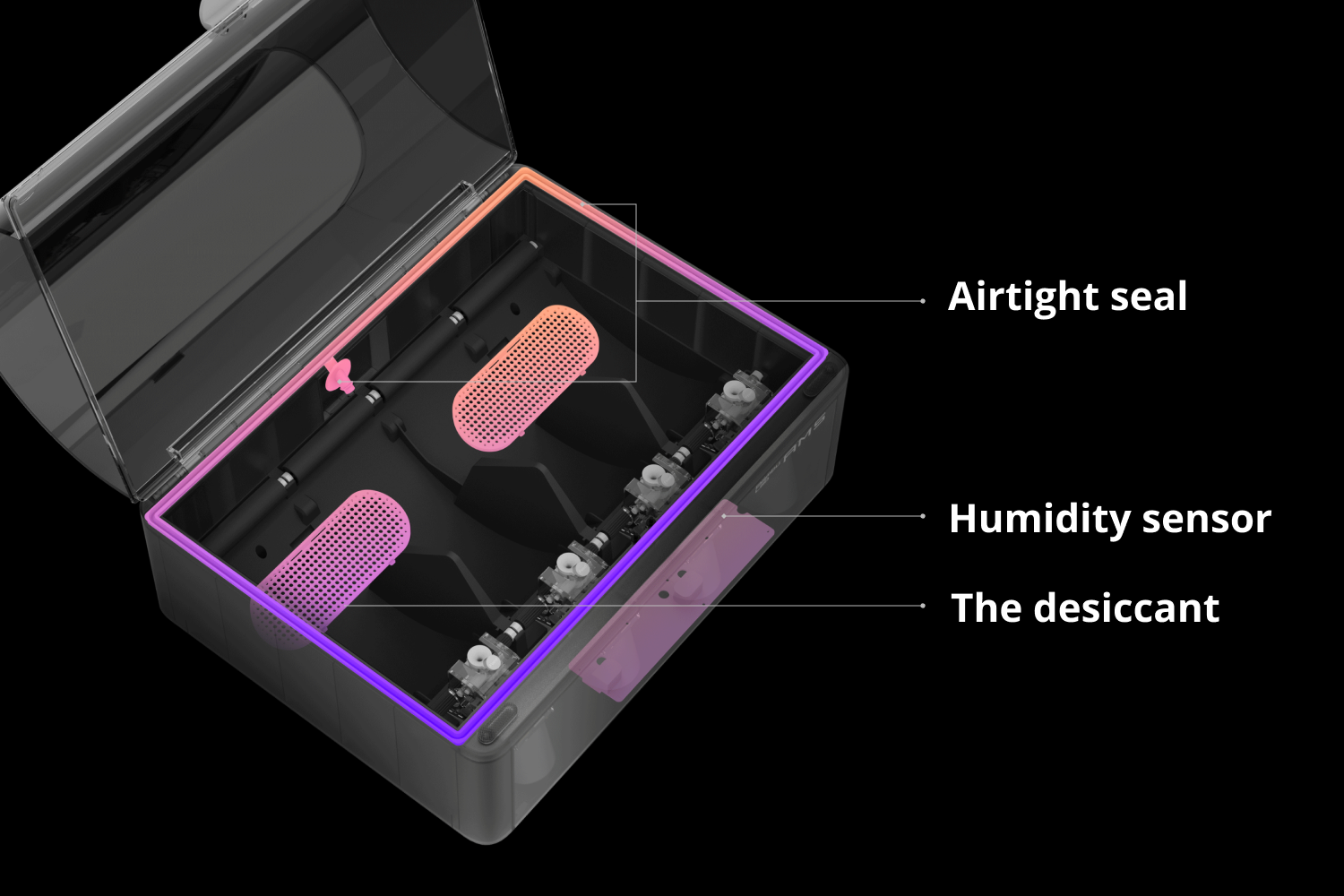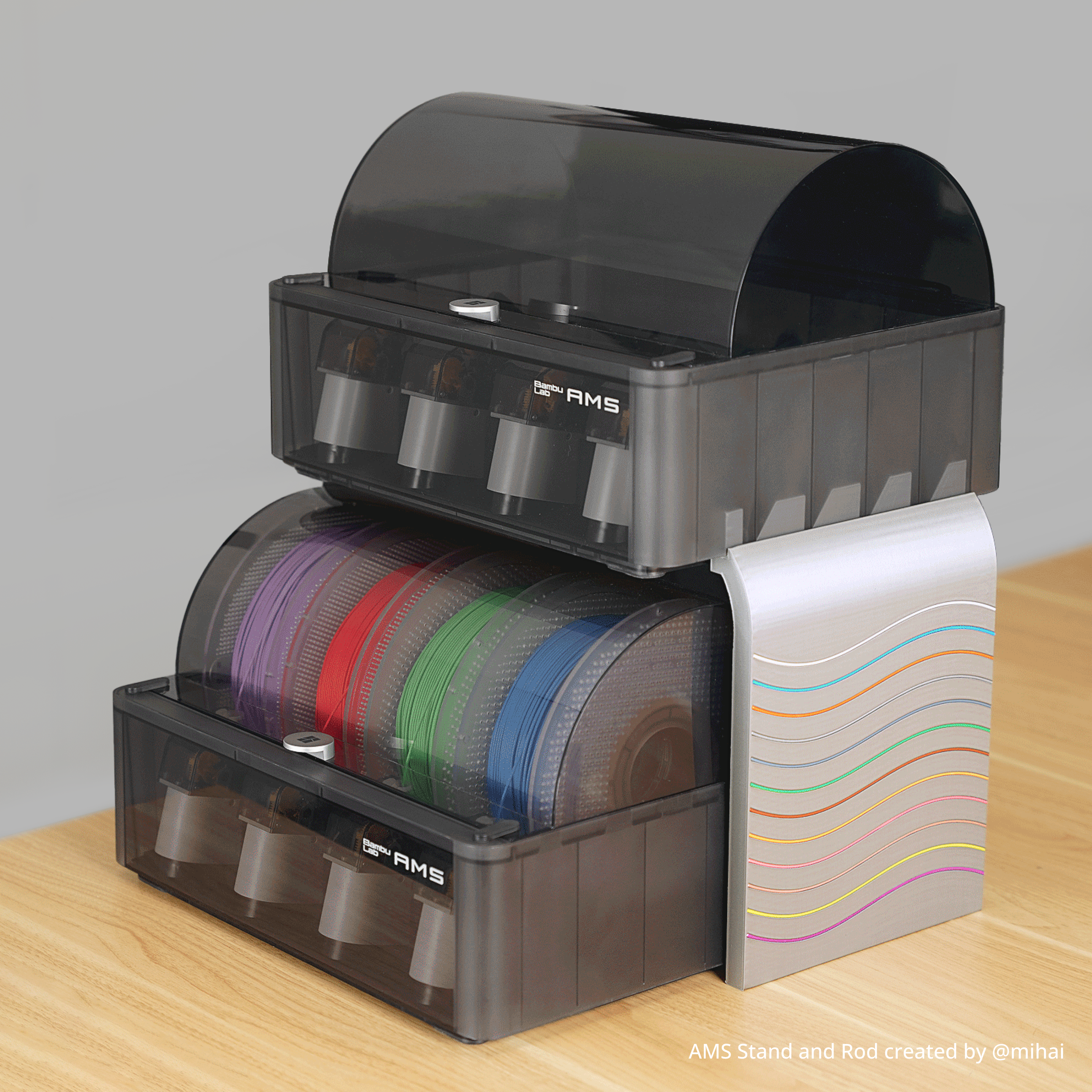Benchy's Gone Wild - The Complete Story
How a beloved 3D printing test model became the center of a licensing controversy that shook the maker community
The Bambu Lab Automatic Material System (AMS) revolutionizes 3D printing by streamlining filament management for multi-material and multi-color projects. Designed to work seamlessly with Bambu Lab’s advanced 3D printers, the AMS automates filament swapping and ensures precise material handling, eliminating manual intervention during complex prints. With its smart storage and compatibility with various filament types, it enhances productivity and reduces the risk of errors, making it an essential tool for professionals and hobbyists alike.
The AMS unit measures 280mm × 224mm × 224mm and can hold up to four 1kg spools of filament simultaneously. It’s compatible with:
A key feature of the AMS is its focus on humidity control, a critical factor in maintaining filament quality. It does this by utilizing an air-tight seal and with the help of desiccant material, it absorbs moisture to keep the moisture away from filament.
A Humidity Sensor also detects the humidity inside the AMS and provides information to the user when the humidity is higher or the desiccant may need to be replaced. The system uses a three-level indicator:

Humidity can wreak havoc on filament properties. When filaments absorb moisture, several issues can arise during printing. Moisture-laden filaments can lead to poor adhesion between layers, causing warping or misshaping of the final print. Additionally, when moisture in the filament is heated during the printing process, it turns into steam, creating tiny bubbles or voids in the extruded material, which severely affects the strength and aesthetics of the print.
Different filaments have varying sensitivities to moisture:
| Filament Type | Critical Humidity | Storage Humidity | Drying Temp | Drying Time |
|---|---|---|---|---|
| PLA | >40% RH | <15% RH | 40-45°C | 4-6 hours |
| PETG | >30% RH | <10% RH | 55-65°C | 6-8 hours |
| ABS | >35% RH | <15% RH | 60-80°C | 4-6 hours |
| Nylon/PA | >20% RH | <10% RH | 80-90°C | 8-12 hours |
| TPU | >25% RH | <10% RH | 50-60°C | 8-12 hours |
| PVA | >15% RH | <10% RH | 45-60°C | 4-6 hours |
At a microscopic level, moisture impacts the filament’s viscosity during the melting process. This alteration can lead to inconsistent extrusion rates, which are critical for precision in 3D printing. Filaments like PLA, PETG, and especially hygroscopic materials like Nylon or TPU can absorb moisture from the air, leading to compromised prints.
When thermoplastic filaments absorb moisture, water molecules integrate into the polymer chains through hydrogen bonding. During extrusion at high temperatures (180-250°C), this absorbed water rapidly converts to steam, causing:
Not all desiccants are created equal. Understanding their properties helps in making informed decisions:
| Desiccant Type | Absorption Capacity | Rechargeable | Cost/kg | Lifespan | Best Use Case |
|---|---|---|---|---|---|
| Calcium Chloride | 200-300% by weight | No | $5-10 | 1-2 months | Single-use, high humidity |
| Silica Gel (Blue) | 30-40% by weight | Yes | $15-25 | 2+ years | General purpose |
| Silica Gel (Orange) | 30-40% by weight | Yes | $20-30 | 2+ years | Eco-friendly option |
| Molecular Sieve | 20-25% by weight | Yes | $30-50 | 5+ years | Low humidity targets |
| Clay Desiccant | 25-30% by weight | Limited | $10-15 | 6 months | Budget option |
Calcium Chloride (CaCl₂): Works through deliquescence - it absorbs so much moisture that it dissolves into a liquid brine. This process is irreversible, making it non-rechargeable. Chemical reaction:
CaCl₂(s) + 2H₂O(g) → CaCl₂·2H₂O(aq)
Silica Gel: Uses adsorption - water molecules stick to the surface of the silica particles. This process is reversible through heating, making it rechargeable. The indicating varieties contain cobalt chloride (blue) or methyl violet (orange) that changes color when saturated.
Although the AMS system performs well in maintaining a consistent and steady humidity level, there is still room for improvement to optimize its performance. While it effectively handles standard conditions, certain scenarios or environmental factors may expose limitations in its ability to maintain ideal humidity levels.
One of the most significant issues I’ve noticed is that the desiccant used (and sold by Bambu) isn’t rechargeable. To be frank, it’s not particularly effective either. Each AMS unit relies on two desiccant packs, which, in my experience, only last about a month—even in a relatively dry environment. And did I mention they’re not rechargeable? This is because the desiccant is made from calcium chloride (CaCl2), which inherently lacks the ability to be regenerated for repeated use.
Calcium chloride is an inorganic compound – a salt with the chemical formula CaCl2. It is white flakes or pellets at room temperature, and is highly soluble in water.
Enter AMS DryPods designed by mcmaven. With over 28k downloads it’s one of the best solutions out there.
Materials:
Tools:
Recommended Print Settings:
Components to Print:
These DryPods are 3d printable and contain printable desiccant trays as well as desiccant containers that slide between the first stage feeder motors. The containers come in several variations to include Wide DryPod options that can hold hygrometers:
Bambu OEM Desiccant:
DryPod with Silica Gel:
ROI Timeline: The DryPod system pays for itself in 3-6 months, depending on humidity levels and usage.
I conducted a 6-month test comparing different desiccant solutions:
Testing with hygroscopic PETG filament showed dramatic differences:
Problem: Humidity not dropping below 20%
Problem: Desiccant beads spilling
Problem: Hygrometer reading seems incorrect
Problem: Filament still showing moisture issues
Sunlu FilaDryer S2:
PolyBox Edition II:
EIBOS Cyclopes:
Food Container Method:
Modified Pelican Case:
Disposable (CaCl₂):
Rechargeable (Silica Gel):
Calcium Chloride:
Silica Gel:
John from Florida (95% humidity): “Living in Florida, humidity is our biggest enemy. The DryPods dropped my AMS humidity from 65% to 15% in just 4 hours. Print quality improvement was immediate and dramatic.”
Sarah from Seattle: “I was skeptical about 3D printing my own solution, but the cost savings are incredible. I’ve saved over $200 in the first year alone.”
Mike from Arizona: “Even in the desert, monsoon season wreaks havoc. DryPods keep my exotic filaments pristine year-round.”
Engineering Firm: Implemented DryPods across 10 AMS units, reporting 75% reduction in failed prints due to moisture issues. Annual savings: $3,000+
School Makerspace: Students maintain the system as part of learning routine. Teaches both 3D printing and material science concepts.
Production Environment: Small batch manufacturer uses modified DryPods with data logging for quality control documentation.
ESP32 Integration:
Home Assistant Integration:
High Humidity (>70% ambient):
Temperature Fluctuations:
The 3D printing community continues to innovate:
Stefan from CNC Kitchen has created an excellent and detailed video exploring the different types of desiccants, their pros and cons, and various methods for drying them. While he focuses heavily on filament bags, the drying techniques he explains are equally applicable to loose desiccant. It’s an insightful resource for anyone looking to optimize moisture control.
The integration of systems like the Bambu Lab AMS with advanced humidity controls such as DryPods using rechargeable desiccant highlights the growing sophistication of 3D printing technology. By tackling the critical issue of humidity’s impact on filaments, these solutions are setting a new standard for reliability and efficiency in 3D printing.
The financial benefits are clear: a one-time investment of $30-65 replaces an annual expense of $100-150, while delivering superior performance. The environmental impact is equally significant, reducing waste by over 90% compared to disposable solutions.
These innovations empower both enthusiasts and professionals to achieve higher-quality results with greater consistency. Whether you’re printing engineering prototypes in humid Florida or artistic pieces in dry Arizona, proper humidity control is no longer optional—it’s essential.
As the industry continues to evolve, systems like these are likely to become standard equipment in the world of additive manufacturing. The question isn’t whether you need humidity control, but rather how quickly you can implement it to start seeing the benefits in your own prints.
Have questions or suggestions? Feel free to reach out in the comments below or join the discussion on the Bambu Lab forums!
